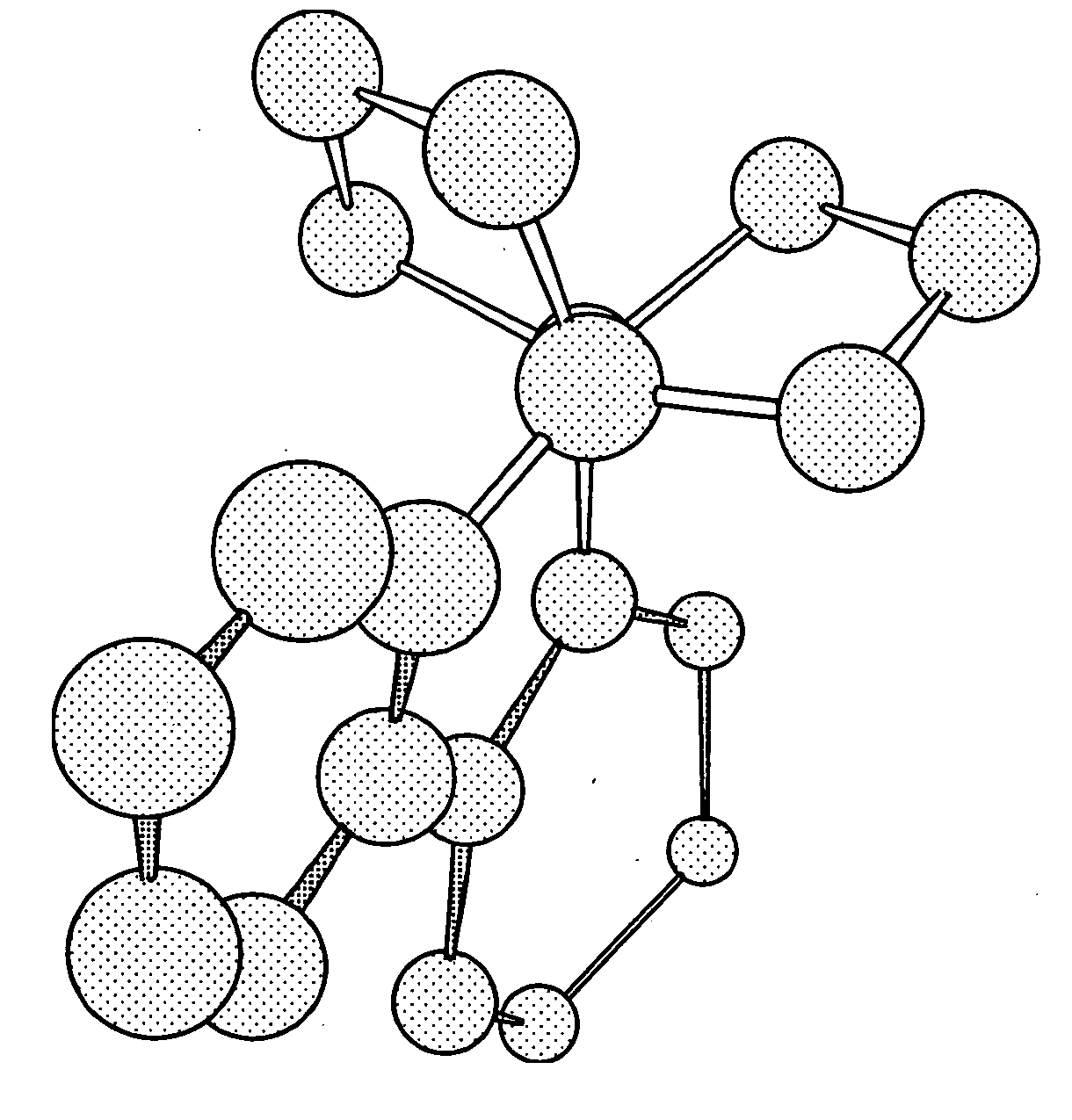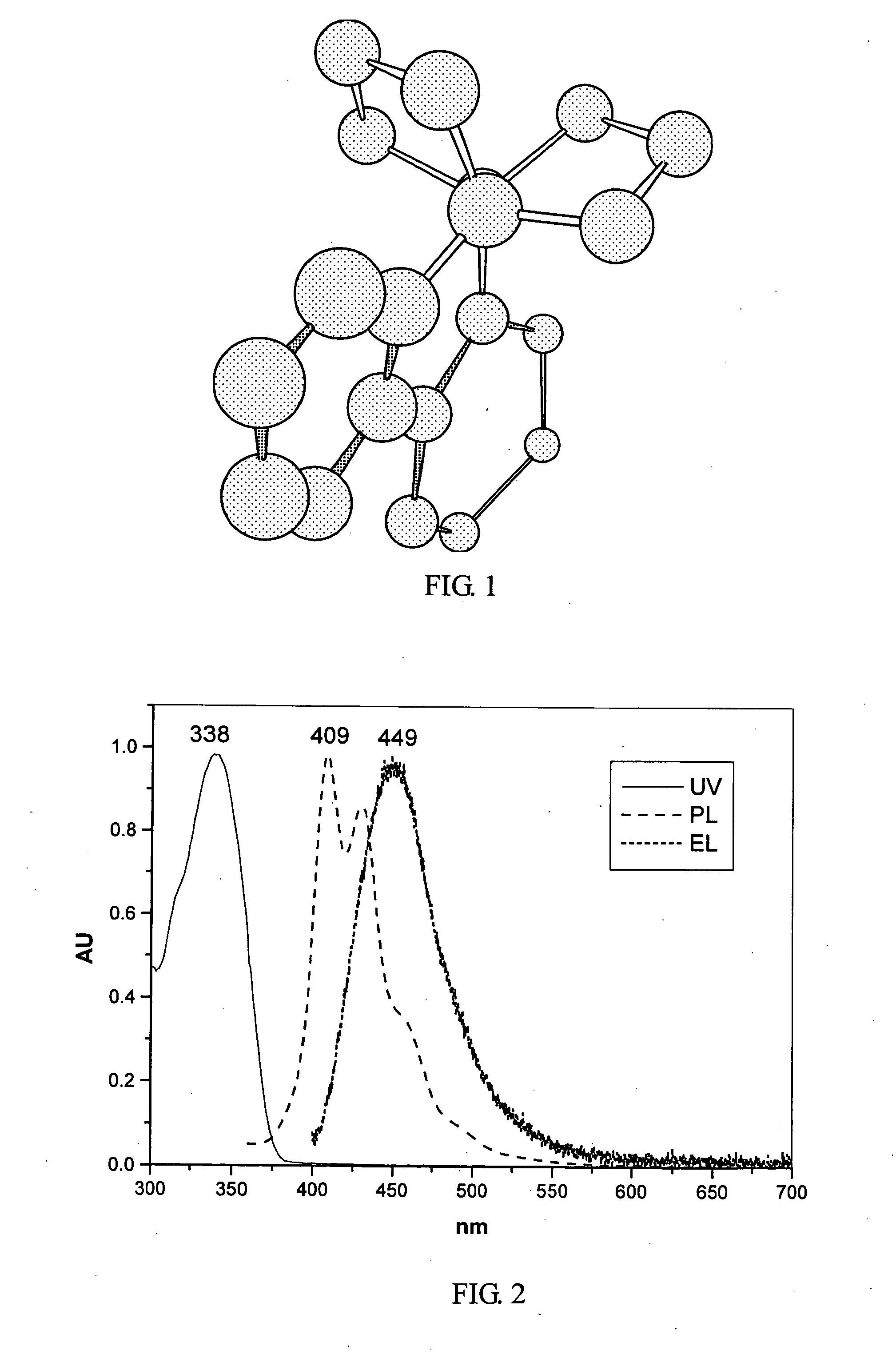Phenanthrene derivatives and organic light-emitting diodes containing said phenanthrene derivative
a technology of organic light-emitting diodes and phenanthrene derivatives, which is applied in the direction of organic chemistry, other domestic articles, luminescent compositions, etc., can solve the problems of device failure and limited effect, and achieve the effect of maintaining the stability of the molecular structur
- Summary
- Abstract
- Description
- Claims
- Application Information
AI Technical Summary
Benefits of technology
Problems solved by technology
Method used
Image
Examples
example 1
Synthesis of 9,10:9,10-bis(trimethylene)-9,10-dihydrophenanthrene
[0051] 2 grams of NaOH was dissolved in 200 ml methanol at 60° C. To the NaOH methanol solution 3 grams of phenanthrene-9,10-diketone and 4 grams of diethyl 1,3-acetonedicarboxylate (manufactured by Aldrich Co., 95%) were added, and the resulting mixture was allowed to react for 36 hours at 60° C. 10% HCl aqueous solution was added to neutralize the reaction mixture and form a precipitate. After filtration, the precipitate was dissolved in acetic acid, followed by addition of 300 ml of 10% HCl aqueous solution, which was then reacted for 18 hrs at an elevated temperature. Then, acetic acid and water were removed, and the product neutralized with sodium hydrogen carbonate aqueous solution, precipitated, and filtered, giving Reactant 1 at a yield of 17%.
[0052] The following reaction scheme illustrates the preparation of Reactant 1:
[0053] 3 grams of Reactant 1 and 150 ml ethylene glycol were mixed, 0.5 grams of N2H4 (...
example 2
Synthesis of 9,10:9,10-bis(trimethylene)-2,7-dibromo-9,10-dihydrophenanthrene
[0055] 2 grams of Compound 1 was dissolved in 20 ml dichloromethane (DCM), and 20 ml of acetic acid solvent was then added. To the solution 3 grams of Br2 (manufactured by ACROS Co.) was added dropwise, and the mixture was allowed to react at room temperature for 3 hours while stirring. White crystalline solid product (Compound 2) was formed at a yield of 75% as a novel phenanthrene derivative of the present invention. 1H NMR (CDCl3): δ (ppm) 1.44˜1.48 (m, 2H), 1.57˜1.65 (m, 2H), 1.92˜1.99 (m, 4H), 2.10˜2.16 (m, 4H), 7.31˜7.33 (d, 2H), 7.48 (s, 2H), 7.68˜7.70 (d, 2H).
[0056] The following reaction scheme illustrates the preparation of Compound 2:
example 3
Synthesis of 9,10:9,10-bis(trimethylene)-2,7-bis-1-naphthalyl-9,10-dihydrophenanthrene
[0057] In a nitrogen atmosphere, 1 ml 2M sodium carbonate aqueous solution and Pd(PPh3)4 as a catalyst were added to a solution of 0.42 grams of 1-naphthaleneboronic acid (manufactured by Lancaster Co., 96%) and 0.5 grams of Compound 2 in 40 ml toluene, and the resulting mixture was heated at 120° C. under refluxing for 12 hours, giving Compound 3 as a white solid at a yield of 75%. Compound 3 is the novel phenanthrene derivative of the present invention. 1H NMR (CDCl3): δ (ppm) about 1.55 (m, 2H), about 1.75 (m, 2H), about 2.18 (m, 4H), about 2.28 (m, 4H), 7.47˜7.54 (m, 4H), 7.62˜7.65 (dd, 2H), 7.76˜7.77 (d, 2H), 7.81 (d, 1H), 7.83 (d, 1H), 7.87˜7.89 (d, 2H), 7.92˜7.95 (m, 4H), 8.06˜8.10 (T, 4H). A film made of Compound 3 has the following maximum absorbance at wavelength: UV: λmax 338 nm. PL: λmax 409 nm. EL: λmax 449 nm, as shown in FIG. 2. The CIE coordinates (x,y) of the emitting light are 0....
PUM
| Property | Measurement | Unit |
|---|---|---|
| Nanoscale particle size | aaaaa | aaaaa |
| Structure | aaaaa | aaaaa |
| Electric potential / voltage | aaaaa | aaaaa |
Abstract
Description
Claims
Application Information
 Login to View More
Login to View More - R&D
- Intellectual Property
- Life Sciences
- Materials
- Tech Scout
- Unparalleled Data Quality
- Higher Quality Content
- 60% Fewer Hallucinations
Browse by: Latest US Patents, China's latest patents, Technical Efficacy Thesaurus, Application Domain, Technology Topic, Popular Technical Reports.
© 2025 PatSnap. All rights reserved.Legal|Privacy policy|Modern Slavery Act Transparency Statement|Sitemap|About US| Contact US: help@patsnap.com



